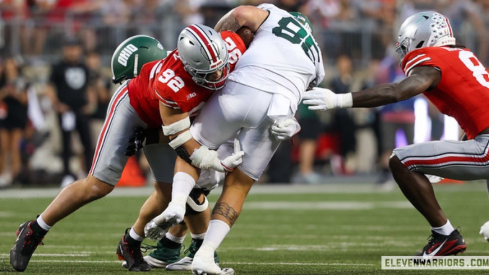 What's 15 yards when you're already up by 17?
What's 15 yards when you're already up by 17? There's no way to get around Meyer's track record in terms of penalties. His Florida teams were consistently the most penalized of all SEC teams over the last five years.
This was hard to accept for some Buckeye fans who were used to Tressel's squads that always were among the least penalized in the BCS. Some openly worried whether the Buckeyes would become undisciplined under Meyer and whether this might cost the team a few wins.
In fact, the Buckeyes went from 39th to 107th in the country for fewest penalties between 2011 and 2012. The Buckeyes lost an average of 20.5 yards more per game due to penalties than the year before.
Obviously penalties aren't a positive thing, but how can we really care about penalty yardage when the Buckeyes went 12-0? Should we fear that increased penalties will cost the team a game or two next year when a national championship berth might be on the line?
The common wisdom is that the least penalized – or most "disciplined" – teams will be the most successful. Alabama seems to be evidence for this hypothesis, as Saban's squads have been the best in the SEC at limiting penalties.
However, is it possible that penalty statistics just don't significantly affect the outcome of games on average?
There happens to be some (limited) large-N statistical research on how penalties affect the probability of winning. Most of these studies conclude that, contrary to our expectations, penalties have an extremely limited impact on the likelihood of winning a game.
A past Stanford study found that "Penalties are a surprisingly negligible component of the statistics" in predicting whether a team will win or not. Further,
A study of nearly 400 high school, college and professional football games was undertaken during the 2003 season...The results showed that high school teams having more penalty yards in a game won two-thirds of those games (67%), while college teams with more penalties won approximately half the time (52%)...The results concluded that in high school the more you were penalized, the greater your chances were of winning. In college, it was about even...
These weren't just cheap penalties like offsides or motion either – the average distance of the penalty was closer to ten yards than five.
The book Sports for Dorks notes that the importance of penalty yardage is situational. A penalty at the wrong moment can doom an important drive, turning a potential touchdown drive into just a field goal. However,
 No risk, no reward.
No risk, no reward. Sample 24 teams won more frequently without an advantage in penalty yardage (81.6 percent) than they did with an advantage (77.2 percent), suggesting that aggression is a necessary attribute of winners, even though the aggressive attitude prompts the occasional slap on the wrist.
Controlled aggression – like a corner playing a receiver tight at risk of a pass interference call – seems to be a risk worth taking in some circumstances.
The 2012 Buckeyes were within one standard deviation (1.02 to be exact) away from the average team in terms of penalties. They ranked near the bottom (107), but weren't that far off from average.
UCLA, on the otherhand, was a truly astonishing 3.22 standard deviations (over 90 yards per game in penalties!) from the mean penalty yards.
Meyer preached turnovers, controlled aggression, and maybe a little more risk taking than Buckeye fans were used to, but they were in no way completely undisciplined.
Furthermore, the limited research so far suggests that it's better to err on the side of risking penalties than it is to be overly conservative. This doesn't mean that Meyer's wants or encourages a lack of discpline or condones playing dirty.
We have to be catious in what we read from these findings - these statistics are "dumb" in that they don't control for the situation or reason for the penalty.
In any case, these numbers demonstrate that the 2012 Buckeyes weren't that far off the national average for penalty yards. Ohio State's average penalty yardage was 9.21 yards per penalty, which was not (statistically) significantly greater than average. As much as average penalty yards per individual penalty can signal the severity or dirtiness of the penalty, the Buckeyes were close to average.
So, will Meyer want to decrease the frequency of costly penalties in 2013? Maybe, but not at the risk of playing scared.

